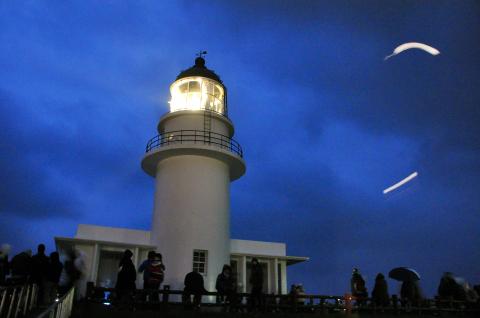The Maritime and Port Bureau under the Ministry of Transportation and Communications yesterday officially replaced the Customs Administration to become the agency in charge of all of the nation’s lighthouses and navigation aids.
To mark the transition of management, the two agencies yesterday jointly unveiled a new lighthouse plaque at the solar energy-powered Keelung lighthouse.
Located in Keelung Port, the 11m-tall brick lighthouse was built in 1900 and the lighting system has a nominal optical distance of 16 nautical miles (29.6km). The nation has a total of 34 lighthouses, 44 light posts and 14 radar beacons, including those in Taiwan proper as well as in the outlying islands of Penghu, Kinmen and Matsu.

Photo: CNA
Maritime and Port Bureau Director-General Li Juel-der (黎瑞德) said the Customs Administration had since 1868 established an excellent system and traditions to manage the nation’s lighthouses.
The bureau will strive to maintain those legacies and seek to improve upon on them, he said.
Li also welcomed the employees from the Department of Marine Affairs, who previously managed the nation’s lighthouses at Customs Administration, to join the bureau.
Li said that the nation’s lighthouses were mostly buildings with long histories and were located in islands with diverse eco-environments.
Yuwongdao (漁翁島) Lighthouse in Penghu County, for example, has been in use since 1778. The granite lighthouse on Dongjudao (東莒島) in Lienchiang County (Matsu), on the other hand, was built in 1872 after the Qing Dynasty lost the opium war against the UK and was forced to open up ports along China’s east coast for trade.
Both lighthouses have been designated as national historical sites by the government, he said.
Li also mentioned the lighthouses in Sandiaojiao (三貂角) and Pengjia Islet (彭佳嶼), both of which were famous for their unique architecture.
According to the bureau, six lighthouses are open to the public — at Yuwengdao, Dongjudao, Cape San Diego, Oluanpi (鵝鑾鼻), Dongyin Island (東引島) and Greater Kaohsiung.
Customs Administration Deputy Director Tseng Ching-yen (曾清煙) said his agency started building lighthouses and other navigation aids in seaports when the Qing dynasty employed British consular official Robert Hart as China’s second inspector-general at the Imperial Maritime Custom Service.
From 1863 to 1911, Hart facilitated the construction of lighthouses and established systems for tax and postal services, he said.
Though the Japanese government managed to build more lighthouses in the colonial era from 1895 to 1945, most of them were severely damaged during World War II, he said.
He said that the Customs Administration took over the management of the lighthouses in 1946 and immediately began restoration work on all the buildings.
Tseng said the nation in 2007 started following the regulations on navigation aids set by the International Association of Marine Aids to Navigation and Lighthouse Authorities, which ensured that the nation’s navigation safety standards are in synch with those of the international community.

ANOTHER EMERGES: The CWA yesterday said this year’s fourth storm of the typhoon season had formed in the South China Sea, but was not expected to affect Taiwan Tropical Storm Gaemi has intensified slightly as it heads toward Taiwan, where it is expected to affect the country in the coming days, the Central Weather Administration (CWA) said yesterday. As of 8am yesterday, the 120km-radius storm was 800km southeast of Oluanpi (鵝鑾鼻), Taiwan’s southernmost tip, moving at 9kph northwest, the agency said. A sea warning for Gaemi could be issued tonight at the earliest, it said, adding that the storm is projected to be closest to Taiwan on Wednesday or Thursday. Gaemi’s potential effect on Taiwan remains unclear, as that would depend on its direction, radius and intensity, forecasters said. Former Weather Forecast

As COVID-19 cases in Japan have been increasing for 10 consecutive weeks, people should get vaccinated before visiting the nation, the Centers for Disease Control (CDC) said. The centers reported 773 hospitalizations and 124 deaths related to COVID-19 in Taiwan last week. CDC Epidemic Intelligence Center Director Guo Hung-wei (郭宏偉) on Tuesday said the number of weekly COVID-19 cases reported in Japan has been increasing since mid-May and surpassed 55,000 cases from July 8 to July 14. The average number of COVID-19 patients at Japan’s healthcare facilities that week was also 1.39 times that of the week before and KP.3 is the dominant

The Chinese Communist Party’s (CCP) working group for Taiwan-related policies is likely to be upgraded to a committee-level body, a report commissioned by the Mainland Affairs Council (MAC) said. As Chinese President Xi Jinping (習近平) is increasingly likely to upgrade the CCP’s Central Leading Group for Taiwan Affairs, Taiwanese authorities should prepare by researching Xi and the CCP, the report said. At the third plenary session of the 20th Central Committee of the CCP, which ended on Thursday last week, the party set a target of 2029 for the completion of some tasks, meaning that Xi is likely preparing to

US-CHINA TRADE DISPUTE: Despite Beijing’s offer of preferential treatment, the lure of China has dimmed as Taiwanese and international investors move out Japan and the US have become the favored destinations for Taiwanese graduates as China’s attraction has waned over the years, the Ministry of Labor said. According to the ministry’s latest income and employment advisory published this month, 3,215 Taiwanese university graduates from the class of 2020 went to Japan, surpassing for the first time the 2,881 graduates who went to China. A total of 2,300 graduates from the class of 2021 went to the US, compared with the 2,262 who went to China, the document showed. The trend continued for the class of 2023, of whom 1,460 went to Japan, 1,334 went to